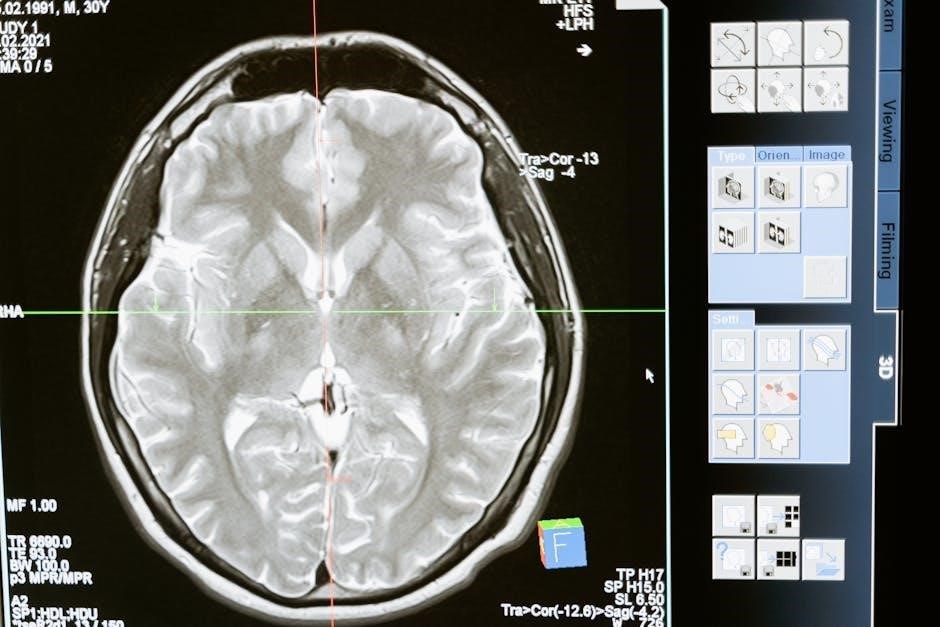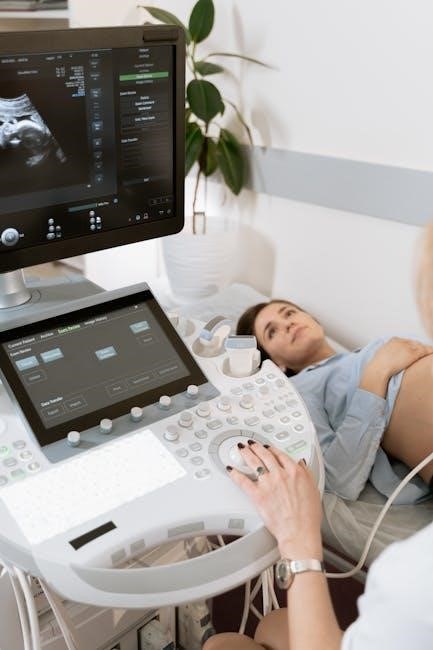The Tinetti Test is a widely used clinical tool to assess balance and gait in elderly patients, helping identify fall risks and guide rehabilitation strategies effectively.

Overview of the Tinetti Test
The Tinetti Test, also known as the Performance-Oriented Mobility Assessment (POMA), is a clinical tool designed to evaluate balance and gait in elderly patients. It consists of two main sections: balance and gait assessment, each containing 16 items scored on a 0-2 scale. The test is task-oriented, requiring patients to perform specific movements like sitting, standing, and walking. This practical approach helps clinicians identify mobility issues and fall risks. The total score ranges from 0 to 28, with higher scores indicating better mobility and lower fall risk. The test is quick, taking approximately 8-10 minutes, and is widely used in geriatric care to guide rehabilitation plans. Its simplicity and effectiveness make it a valuable resource for assessing functional independence and stability in older adults. The Tinetti Test is particularly useful for identifying individuals at high risk of falls, enabling early interventions to improve safety and quality of life.
Importance of the Tinetti Test in Assessing Fall Risk
The Tinetti Test plays a crucial role in identifying elderly patients at risk of falls by evaluating their balance and gait abilities. Falls are a leading cause of injuries and mortality in older adults, making early detection and intervention vital. The test’s structured assessment provides actionable insights, enabling healthcare providers to develop targeted interventions. Its scoring system categorizes fall risk as low, moderate, or high, helping to prioritize care and prevent falls. By addressing mobility issues early, the Tinetti Test supports safer, more independent living for older adults. Regular use of this tool in clinical settings has proven effective in reducing fall-related complications and improving overall patient outcomes. Thus, it remains a cornerstone in geriatric care for assessing and managing fall risks effectively.

Structure of the Tinetti Test
The Tinetti Test consists of two main sections: Balance and Gait assessments. Each section evaluates specific mobility tasks, providing a comprehensive evaluation of a patient’s motor abilities and fall risk.
Balance Assessment Section
The Balance Assessment Section of the Tinetti Test evaluates a patient’s ability to maintain equilibrium during various static and dynamic tasks. It includes activities such as sitting balance, where the patient is seated in a hard, armless chair, and standing balance, where the patient stands with feet together, first on a firm surface and then on a soft or foam surface. Additional tasks involve standing with eyes closed and turning 360 degrees. Each task is scored on a 0-2 scale, with higher scores indicating better balance. The section also assesses the patient’s ability to recover from a loss of balance and their overall stability during transitions, such as moving from sitting to standing. This portion of the test provides critical insights into the patient’s static and dynamic balance abilities, helping clinicians identify specific areas of weakness and fall risks.
Gait Assessment Section
The Gait Assessment Section of the Tinetti Test evaluates a patient’s walking ability and mobility. Patients are asked to walk across a room at their usual pace and then at a rapid pace, with or without assistive devices. The assessment focuses on gait characteristics such as step length, step height, step symmetry, and path deviation. Observations are made on the patient’s ability to initiate gait, maintain a consistent pace, and turn smoothly. Each gait task is scored on a 0-2 scale, with higher scores indicating better gait performance. This section also evaluates the patient’s hesitancy or difficulty in starting to walk and their overall confidence during the task. The gait assessment provides valuable insights into the patient’s mobility and helps identify gait abnormalities that may contribute to fall risks, guiding targeted interventions to improve walking patterns and reduce the likelihood of falls.

Scoring and Interpretation
The Tinetti Test is scored from 0 to 28, with higher scores indicating better mobility. A score of 24 or above suggests low fall risk, 19-23 moderate risk, and 18 or below high risk.
How to Score the Tinetti Test
The Tinetti Test is divided into two sections: balance and gait, each containing 16 items scored on a 0-2 scale. For balance, tasks like sitting, standing, and reaching are assessed. Gait evaluates walking patterns, step symmetry, and ability to pivot. Each item is scored based on observed performance, with 2 indicating normal ability and 0 for severe impairment. The total score ranges from 0 to 28, combining both sections. Scores are categorized as follows: 24-28 for low fall risk, 19-23 for moderate risk, and ≤18 for high risk. The test is validated for use in clinical settings and provides clear, objective measures of mobility. Scorers must ensure consistency and accuracy to reliably interpret results and guide patient care effectively. Proper training is recommended for administrators to ensure accurate assessment. This tool is widely recognized for its simplicity and effectiveness in fall risk assessment.
Interpreting the Results

The Tinetti Test results are interpreted based on the total score, ranging from 0 to 28. Scores are categorized into three risk levels: high, moderate, and low. A score of 24 or above indicates a low risk of falls, suggesting good balance and gait abilities. Scores between 19-23 are considered moderate risk, indicating some mobility challenges that may require monitoring or intervention. A score of 18 or below signifies a high risk of falls, necessitating immediate attention and rehabilitation strategies. The test also provides separate insights into balance and gait components, helping clinicians pinpoint specific areas needing improvement. Accurate interpretation relies on proper administration and scoring. These results are valuable for developing targeted treatment plans to enhance stability and reduce fall risks in elderly patients. Regular reassessment can track progress and adjust interventions as needed. This tool is widely recognized for its effectiveness in clinical and rehabilitation settings.

Advantages and Limitations
The Tinetti Test is a validated, easy-to-administer tool for assessing fall risk, offering clear scoring and interpretation. However, it is considered somewhat approximate and may not assess all mobility aspects thoroughly.
Advantages of Using the Tinetti Test

The Tinetti Test is a validated and reliable tool for assessing balance and gait in elderly patients, providing clear insights into fall risk. It is easy to administer, requiring minimal equipment, and can be completed in 8-10 minutes, making it practical for clinical settings. The test’s task-oriented design allows clinicians to observe realistic mobility challenges, enhancing its applicability. The scoring system is straightforward, with specific criteria for each task, ensuring consistency across evaluations. This tool is particularly effective for identifying high-risk patients and guiding personalized intervention plans. Additionally, the Tinetti Test has been validated in numerous clinical studies, reinforcing its credibility. Its focus on functional mobility makes it an invaluable resource for promoting stability, confidence, and independence in older adults. Overall, the Tinetti Test offers a cost-effective, non-invasive method for assessing and managing fall risks in geriatric populations.
Limitations of the Tinetti Test
Despite its effectiveness, the Tinetti Test has several limitations. It relies heavily on the examiner’s observational skills, which may lead to variability in scoring. The test does not account for cognitive impairments or psychological factors that could influence performance. Additionally, it may not fully capture the complexity of real-world mobility challenges; The test’s focus on balance and gait excludes other important aspects of mobility, such as upper limb function. Some critics argue that the scoring system is too simplistic, potentially overlooking subtle differences in patient abilities. Furthermore, the test’s effectiveness in non-elderly populations or those with specific conditions remains unclear. While it is useful for identifying fall risks, it does not provide a comprehensive assessment of overall mobility or functional independence. These limitations highlight the need for complementary assessments to ensure a more holistic evaluation of patient mobility and fall risk.

